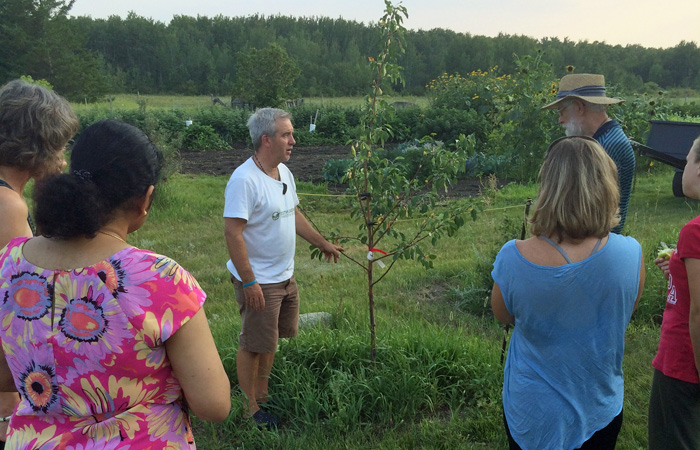On August 9th, SETI hosted a tour of a “food secure” garden near La Broquerie. Gabriel Gagne was our host and guide as we walked through his 0.18ac vegetable garden last Thursday. An experienced gardener, Gabriel is able to harvest many hundreds of pounds of produce each year, in the traditionally very poor soil of the Kokomo Road development. Gabriel considers that he typically harvests enough for approximately 8 adults annually. We learned that he maintains fertility, partly by planting produce in only about half of his garden each year, sowing the rest with buckwheat or mixtures of fall rye, alfalfa and clover. This green manure crop he terminates and tills into the soil before it goes to seed. This way he is able to grow 2-3 green manure crops each season. The green manure enriches the soil, increases the soil ability to retain water, and suppresses weeds that would grow if it were kept as a black fallow. Each species of green manure has its own special characteristics. Gabriel selects weed suppression and growth rate, which meets his specific need. Although off-site compost is a great investment for soil improvement, and Gabriel uses it, but it is a limited resource. When he does apply compost, Gabriel employs a “micro-fertilizing” strategy, in which he applies compost directly to the plants he wants to grow – not to the weeds between rows.
One of the challenges of gardening is harvesting and preservation. Gabriel cans, ferments (makes sauerkraut) and dehydrates. He has a special “cold room” in his basement where he preserves his winter vegetables. He finds other crops, like parsnips, will keep if they are left in the garden and harvested in spring.
He opts for fruit varieties that ripen at different times, including a late-ripening raspberry that we learned has yet another advantage. While most raspberries produce fruit on last year’s growth, the Autumn Gold variety produces berries on this year’s cane. This means that you don’t need to prune selectively – you can just mow the whole patch down in Fall.
Looking at his potatoes, Gabriel pointed out that one variety was doing significantly better than another one just beside it. “Milva” variety is significantly more resistant to early blight, and consequently produces a better yield. He also observed that mulching the potato plants helps the soil stay moist all summer, increasing the yield significantly. Every year, Gabriel visits neighbours and friends to collect as many bags of leaf-rakings as he can. It’s an excellent mulch and a real time-saver for watering and weeding, even while it builds the soil. Since his garden is always in rotation, Gabriel takes care not to plant the same annual crop in the same place in consecutive years. This reduces disease and pests like potato bugs. Fortunately, perennial plants are less susceptible to seasonal threats. Gabriel’s garden has Jerusalem artichokes (a potato-like tuber with a nutty flavour), raspberries, loveage, borage, comfrey and of course, Egyptian “walking” onions.
Our tour of Gabriel’s garden was a delight, and we learned a lot. This is an example of how one person with a small piece of land and lots of hard work can provide healthy food for many.




